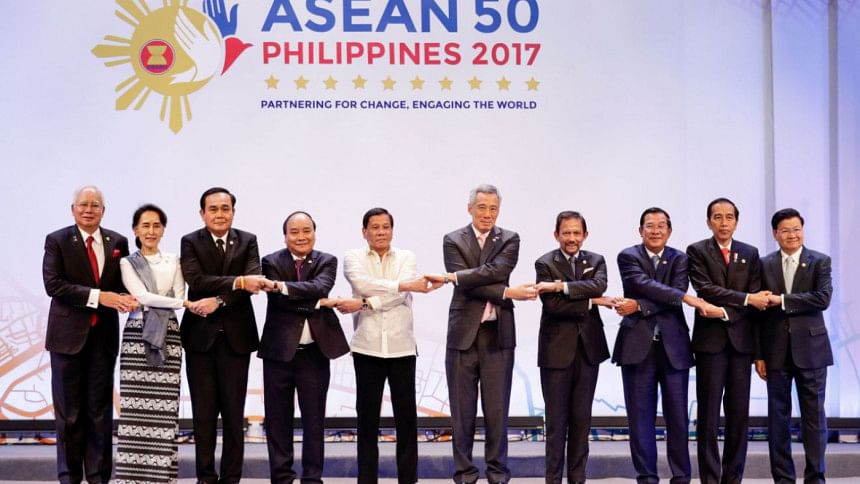The future of Asean

ASEAN marked its 50th anniversary as a regional organisation last year. Year-round events were spanned out to celebrate the functioning of an organisation that was predicted to wither away or collapse by political analysts at the time of its formation. The former Asean Secretary General, Narciso G Reyes, had once remarked that success of Asean should be quantified by imagining a "Southeast Asia minus ASEAN" which would have resulted in greater political instability, widespread economic stress and rise of expansionist propaganda by actors thriving on disunity amongst states.
The miracle of Asean lies in the politically and ideologically diverse constituent members functioning on the much talked about principle of consensus and not the method of majority. It is also committed to the principles of cooperation and pragmatism. Which is why reputed academics like Kishore Mahbubani and Jeffery Sng recommend the organisation's working as "a catalyst for peace" to be recognised for the Noble Peace Prize.
In an interesting play of geopolitical events starting from 2016, with some similarity from the events of 2012, the centrality of Asean unity has been projected in a tainted light. Amidst the emerging turmoil in the global order with distorted hegemonic picture and shifting focus of global audience towards Indo-Pacific region, the importance of a united Asean has taken the central point of discussion.
In 2016, a joint statement on the South China Sea dispute was issued by Asean expressing "serious concerns" over the disputed waters. However, the communique was shortly retracted quoting "urgent amendments" to be made to the statement and later an amended statement was not issued. Although the statement did not mention China, it did indirectly imply that China had a hand in tensions rising.
The two countries reported to have withdrawn their support were Cambodia and Laos. A similar play of events was witnessed in 2012 where under the chairmanship of Cambodia, the Asean summit was unable to release a joint statement mentioning the concerns over the South China Sea, despite insistence from the Philippines and Vietnam.
With the 2016 arbitration resulting in negative assertion over China's activities in the disputed waters of the South China Sea, the inability of Asean to bring member states in consensus highlights the extent of Chinese inroads into the regional community of Asean.
China with its strong cheque-book diplomacy already has strong hold over the political affairs of Cambodia and Laos, by which both the countries have stayed away from commenting on the South China Sea dispute. China is now expanding its political influence over other players in the community by investing in economic diplomacy. For example, Indonesia and Myanmar have considerable exports to China.
Brunei devasted the consensus by not participating in the first Asean Claimants Working Group in 2014 which was organised by the Philippines to foster Asean consensus amongst the overlapping claims of its constituent members. This move came right after excessive investment by China in Brunei when it was on the verge of an oil crisis in 2014.
Singapore, on the other hand, is the largest importer from and second-largest exporter to China. Recently, the Philippines changed its stance. President Rodrigo Duterte welcomed Chinese infrastructure investment, unlike his predecessor President Benigno Aquino, who was a staunch critic of Chinese hegemonic designs and claims over the disputed waters. With each country's self-interest at stake, forging an Asean consensus especially against the China seems highly implausible.
The economic projections for Asean in the near future appear to be bright and promising. According to the World Economic Forum on Asean 2017, the overall yearly growth rate of Asean is placed at five percent. Collectively, Asean nations form the seventh largest economy in the world. It is expected to improve to fifth by 2020. At five percent, Asean countries are expected to double their income in 15 years.
With the continuance of the growth trajectory, a minor increase of even two percent in annual growth rate will cause Asean nations to double their income in a matter of 10 years. This growth rate can be achieved by the implementation of Asean Economic Community which still stands as a distant dream. Furthermore, Asean nations can reap the benefits of demographic dividend only till 2025. The probability of achieving these economic benefits is contingent on a united Asean community. Thus, the centrality of Asean unity is more relevant today than ever before.
Asean today stands at a crossroads where divergence can be seen in its united appearances on the one hand and possibility of fragmented consensus in the near future on the other. In January 2018, India hosted the 10-nation community for the India-Asean summit where the communique issued spoke of a united front of Asean and India to counter regional challenges.
Another opportunity to project Asean unity was the summit held in Singapore late April this year where the issue of the South China Sea dispute was on the agenda. However, the summit concluded on April 28 with full display of differences among member states, including issues such as the legal and diplomatic processes and a proposal by Vietnam and the Philippines to welcome the July 2016 arbitral tribunal award.
Simultaneously, the Philippines is fostering very close ties with China where there are talks being held on potential sharing of water resources in the disputed areas of the South China Sea. China is also making strong inroads in Vietnam. It will be interesting to see if an Asean consensus can be formed or at least attempted, especially when the Philippines takes over the role of Asean country coordinator for the Asean-China dialogue in August 2018.
Nehginpao Kipgen is Associate Professor and Executive Director and Soumya. Chaturvedi is a Masters student and Research Assistant at the Center for Southeast Asian Studies, Jindal School of International Affairs, OP Jindal Global University.





Comments